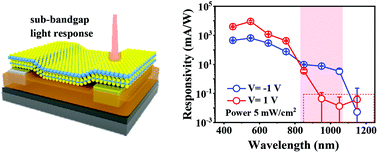High performance sub-bandgap photodetection via internal photoemission based on ideal metal/2D-material van der Waals Schottky interface†
Abstract
Two-dimensional (2D) materials have been demonstrated to be promising candidates to design high performance photodetectors owing to their strong light–matter interaction. However, the performance of 2D material photodetectors is still unsatisfactory, such as slow response speed due to defects and vulnerable contact interface, which impede their rapid development in the field of optoelectronics. In this paper, we obtained the ideal and large photosensitive van der Waals Schottky interface by the laminating-flipping method. Hence, a fast response speed (<1 ms) and high detectivity (>1012 Jones) are observed on the van der Waals Schottky junction photodiode. More importantly, benefiting from the flat Schottky interface (the roughness ∼0.6 nm), a sub-bandgap light response modulated by the Schottky barrier height (cut-off edge at 1050 nm) has been detected based on the large Au/MoSe2 sensitive Schottky interface internal photoemission. As a result, a universal strategy for the sub-bandgap near-infrared van der Waals Schottky junction detector of 2D materials was obtained.



 Please wait while we load your content...
Please wait while we load your content...